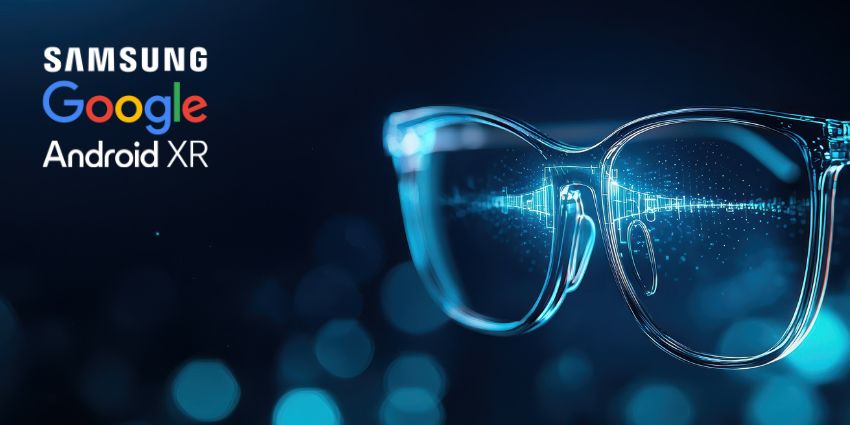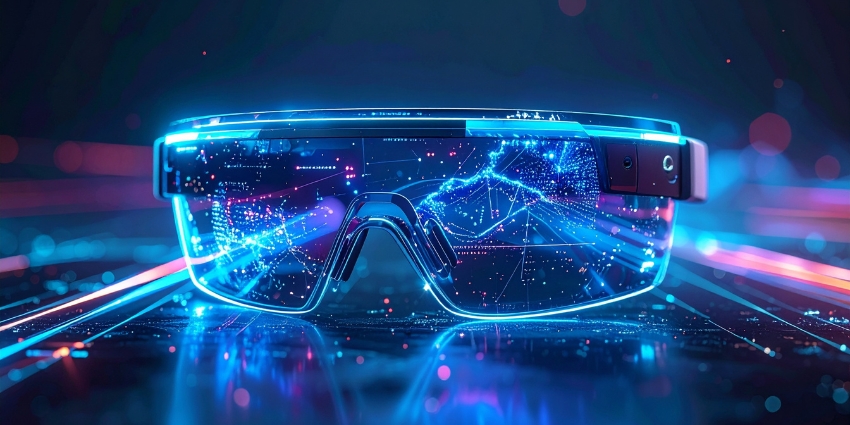A lot of office tech promises to change the way people work. Most of it doesn’t. Samsung AR Glasses actually might. Earlier this year, Samsung and Google confirmed they were building a new pair of smart specs together, and even showed off a prototype during a TED talk hosted by Shahram Izadi, Google’s head of augmented reality and extended reality.
While the sleek, lightweight glasses impressed with their capabilities, reports suggest we might need to wait until 2026 before they hit the market.
Still, it’s becoming increasingly obvious this isn’t just another lab project. It’s a plan to bring Samsung AR and Google AR tools into real workplaces, where they can support teams that already rely on Galaxy devices, Android apps, and cloud-based communication tools.
The setup for that future is already here. Samsung’s Galaxy XR headset arrived in 2025 with the same Android XR platform that the glasses will use. It connects to phones, tablets, and collaboration apps without needing a new ecosystem. The company’s message is simple: AR should fit into how people already work.
That’s why this story matters to businesses. These glasses aren’t designed for gamers or hobbyists. They’re being built for engineers, field service teams, and hybrid offices trying to stay connected across time zones. Samsung AR Glasses could turn ordinary communication into something closer to real presence: hands-free, visual, and part of daily workflow.
Samsung AR Glasses: What We Know So Far
When news surfaced that Samsung and Google were building a pair of AR glasses together, no one knew what to expect. Now, we’ve seen an actual demonstration, complete with crucial features like:
- Live translation from Farsi to English
- Document scanning using built-in cameras
- A “Memory” feature that helps locate misplaced items
- Integrated display for visual information
The glasses even looked much slimmer than many other AR prototypes, like Meta’s potentially upcoming Orian AR specs.
Samsung’s focus was clear from the start. It would handle the hardware, the design, and the display tech it’s known for. Google would do what it does best: software, AI, and the Android backbone that most of the world already runs on. The plan wasn’t to reinvent the wheel but to make Samsung AR Glasses fit neatly into the Galaxy ecosystem and the growing Google AR platform.
As Izadi explained:
These glasses work with your phone, streaming back and forth, allowing the glasses to be very lightweight and access all of your phone apps.
This design strategy likely allows Google to create a more streamlined form factor by offloading heavy processing to the smartphone rather than packing everything into the glasses themselves. The result is a more wearable device that might still deliver impressive performance.
Samsung AR Glasses: The Latest Updates
A year ago, talk about Samsung AR Glasses still sounded like a vague promise. Now, it feels more like preparation. Pieces that used to be theory are starting to show up in real products.
Samsung’s Galaxy XR headset (Project Moohan) arrived this fall, powered by Android XR, the same platform that will run the glasses.
Companies are starting to see how Samsung AR blends into their current systems. The Galaxy XR headset already syncs with Galaxy phones, connects to business software, and taps into Google’s AI for voice and gesture control. It offers a preview of the experience those glasses are being designed to deliver. The upcoming set of glasses will be more lightweight, focused on audio prompts, notifications, and live translation.
Right now, partnerships are widening too. Teams inside Google AR have been working with Magic Leap on new lens tech, while Samsung keeps refining hardware with Qualcomm using the Snapdragon XR2+ Gen 2 chip. Each bit of progress nudges the 2026 goal for next-generation wearables a little closer.
The market is expanding too. IDC projects enterprise spending on AR and VR to rise nearly 20 percent this year, to about 12 billion dollars worldwide. Most of that growth is coming from companies investing in training, remote collaboration, and digital twin projects, precisely the kind of work Samsung AR Glasses are being designed to support.
The Competitive Landscape
Samsung AR Glasses have the clearest business story right now. They sit at the center of Samsung’s growing Galaxy ecosystem and plug into the same Android XR platform used by the Galaxy XR headset. For IT leaders, that’s a real advantage: one operating system, one security model, one management stack. It’s the same logic that helped smartphones break into the enterprise years ago.
Google AR is evolving fast, too. The company’s engineers have been working with Magic Leap on display prototypes built around micro-LED technology, pairing that with Gemini AI for real-time assistance.
Apple seems to be pacing itself. Reports point to a shift toward lighter, AI-focused smart glasses that would follow the Vision Pro. The projected window runs somewhere between 2026 and 2028. That slower rollout could actually work in Samsung and Google’s favor, giving them more room to win over enterprise customers, where integration and reliability matter far more than shiny new features.
Meta remains the wild card. Its Ray-Ban line has proven there’s a real appetite for smart glasses that look and feel normal. The company’s push into AI-powered glasses with included displays has turned what started as a consumer product into something businesses are quietly testing for field communication and content capture.
Why Business Buyers Should Care
The draw of Samsung AR Glasses isn’t the device itself; it’s what they do to communication. Most workers spend their day hopping between screens: phones for quick calls, laptops for video, tablets for everything else. These glasses aim to close that gap, keeping people connected without all the juggling.
Picture a field engineer repairing a generator while a specialist joins through the glasses, seeing the same view, sketching quick instructions on the live feed, and closing out the task remotely. That’s the kind of hands-free workflow Samsung’s Galaxy XR headset has already started to deliver, and the glasses will make it even lighter.
There’s also a shift happening across the market. Smart glasses are starting to rival phones as the main device for daily communication. Voice, spatial audio, and visual prompts are gradually replacing screens for short interactions.
Hybrid collaboration is where this really lands. Instead of staring at grids of faces, imagine meeting spaces that blend the physical and digital. That’s what companies like Samsung are starting to deliver.
Before Investing in Samsung AR Glasses: What to Consider
Before rolling out Samsung AR Glasses, it helps to pause for a reality check. New hardware always sounds promising, but turning it into something reliable takes work. Pay attention to:
- Device management and security: These glasses will share the same networks as laptops and phones, which means they’ll need the same controls. Since Samsung and Google are building everything on Android XR, existing management systems should recognize and secure them without much adjustment. That consistency might not grab headlines, but it’s what keeps IT teams sane.
- Integration with collaboration tools: A pair of glasses only earns its keep when it fits naturally into workflows. The advantage of Samsung AR running on Android XR is that it can tap into Microsoft Teams, Webex, Zoom, and other UC platforms without complex bridging. Companies should begin testing these integrations now through the Galaxy XR headset to see where friction still exists.
- Workflow readiness and training: It’s one thing to buy new devices; it’s another to redesign work around them. Field service, training, logistics, and hybrid meetings all benefit from hands-free visual guidance, but they’ll need updated procedures. Businesses should pick one process and run a small pilot to measure productivity gains before scaling.
- Measuring ROI: Forget the flashy stats, look at what’s measurable. Track repair times, error rates, first-time fixes, and how many on-site visits you avoid. In early rollouts, organizations using AR support tools have cut service times by roughly 30–40 percent. Multiply that across multiple sites, and the payoff becomes obvious.
For organizations already deep in the Galaxy ecosystem, the simplest move is to pilot the Galaxy XR headset now. It runs on the same platform as the upcoming glasses, so the lessons transfer directly. Treat it as groundwork, testing connectivity, workflows, and content policies before Samsung AR Glasses arrive.
Looking ahead with AR Smart Glasses for Enterprises
The idea of wearing your workspace once sounded far-fetched. Now it feels close. The partnership between Samsung and Google has given Samsung AR Glasses a real timeline and, more importantly, a purpose that makes sense in business.
Every major tech wave has started this way, with tools that seem small until they start solving problems people didn’t realize could be fixed. The smartphone replaced clipboards. Video calls replaced most travel. Samsung AR and Google AR could be the bridge that finally makes digital work feel natural again.
The advantage Samsung has isn’t just hardware. It’s the ecosystem: the phones, tablets, displays, and now wearables that already fit inside the same Android environment. When the glasses arrive, they’ll plug into that world without forcing companies to start over. That’s a big deal for IT teams that live and die by compatibility.
Apple and Meta will keep the pressure on, and that’s good for everyone. Competition tends to speed up the useful parts of innovation. But right now, Samsung and Google have momentum and a platform that fits how businesses already operate.







